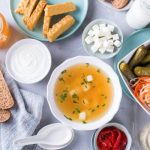There is a lot of confusion about prebiotics and probiotics. And then there is another type “biotic” altogether, called postbiotics, that most people don’t even know about.
What are they? Where do they come from? How are they different from one another?
Let’s start with the basics.
Probiotics are live bacteria that add to the population of healthy microbes living in your gut. And you know how important a healthy gut microbiome is!
The gut is your prime source of immunity against ANY type of infection – viral, bacterial, fungal or whatever happens to invade your body.
It manufactures about 90 percent of your body’s supply of serotonin. You’ve probably heard of this neurotransmitter before. Low levels of it are associated with stress, anxiety, depression and fatigue.
Your gut helps with the production of other brain chemicals too, like GABA, dopamine, norepinephrine and acetylcholine. All of these can affect your emotions, sleep patterns and stress levels.
More importantly, serious health conditions like Crohn’s disease, irritable bowel syndrome, immune disorders, metabolic disturbances, depression, chronic fatigue, heart disease, reduced brain function and arthritis can be all linked back to your gut microbiota.
So basically, the more live bacteria you get from probiotic foods or supplements, the better off your health will be.
Fermented foods like kimchi, miso, natto, kefir, tempeh and sauerkraut are some of the best dietary sources of probiotics.
But probiotics are only one part of a healthy gut microbiome.
What do Prebiotics do?
Unlike probiotics, prebiotics don’t have any bacteria in them. Instead, they act as food for probiotic bacteria.
I like to think of them as fertilizer for your gut microbes, because they stimulate the growth of healthy bacteria in the gut. They help keep those good bugs alive and thriving, and promote microbial diversity in the gut.
But when the gut bugs are underfed, it can become a big problem.
When the gut microbes are starved of prebiotic foods, they have to look for another food source. Some of them die. But others start feeding on the mucosal barrier.
When this occurs, it allows bacteria, toxins, toxicants, previously tolerated foods and other exogenous material to enter your bloodstream. This, in turn, causes your immune system to go into attack mode.
Your gut bugs make up 70% of your immune system, and you don’t want them to turn on you. So it’s a good idea to keep them fed plenty of prebiotic foods.
You’ll find prebiotics in foods that contain indigestible carbohydrates in the form of fermentable fiber and resistant starches.
Fruits like bananas, grapefruit, apples and nectarines all contain fermentable fibers. Cruciferous veggies, squash, beets and mushrooms can go on the list. And then you have almonds, pistachios, cashews and other nuts. Grains, too. But I recommended sticking with gluten-free grains such as millet, quinoa and buckwheat.
And by the way… forget about all of those prebiotic sodas that have hit to markets in recent years. You would have to drink 20 or more of these sodas to even approach a useful dose of prebiotic. But there would be no diversity, so that would be pretty useless. You would just end up feeling bloated and gassy.
Here’s What Happens When You Feed Your Gut Bacteria
When your gut bugs feed on prebiotics, they produce byproducts known as postbiotics. Scientifically, I would say that postbiotics are “metabolites produced by gut microbes that offer a potential health benefit to the host body.”
Chief among these metabolites are short-chain fatty acids (SCFAs) like butyrate, acetate and propionate.
SCFAs are a primary energy source for cells of the colon’s lining and help to strengthen the intestinal barrier. They also have a positive impact on immune response, lipid profile, blood sugar, bone health, mineral absorption, bowel function and weight.
And it’s interesting to note that postbiotics actually promote a healthier prebiotic population.
Some fermentable fiber foods that are especially good at promoting SCFA producing bacteria include lentils, chickpeas, kidney beans, asparagus, Jerusalem artichokes, garlic, onions, cabbage and both snow and green peas.
So all of these things work together. Probiotics improve the microbial community in your gut. Prebiotics feed probiotic bacteria to help the good guys flourish. And when good bacteria chow down on the prebiotics, postbiotics – which have their own health benefits – are produced.
SOURCES:
Strandwitz P. Neurotransmitter modulation by the gut microbiota. Brain Res. 2018;1693(Pt B):128-133.
Davis CD. The Gut Microbiome and Its Role in Obesity. Nutr Today. 2016;51(4):167-174.
John GK. Dietary Alteration of the Gut Microbiome and Its Impact on Weight and Fat Mass: A Systematic Review and Meta-Analysis. Genes (Basel). 2018;9(3):167.
Durack J, Lynch SV. The gut microbiome: Relationships with disease and opportunities for therapy. J Exp Med. 2019;216(1):20-40
Bull MJ, Plummer NT. Part 1: The Human Gut Microbiome in Health and Disease. Integr Med (Encinitas). 2014;13(6):17-22.
Davis SC, Dosonmu-Ogunbi ABO, Dosunmu-Ogunbi SO, Barrow SD, Robertson BK. Understanding the Nutritional Needs of the Gut Microbiota. J Hum Nutr Food Sci. 2016;4(1):1079.
Kerry RG, Patra JK, Gouda S, Park Y, Shin HS, Das G. Benefaction of probiotics for human health: A review. J Food Drug Anal. 2018 Jul;26(3):927-939.
Davani-Davari D, Negahdaripour M, Karimzadeh I, et al. Prebiotics: Definition, Types, Sources, Mechanisms, and Clinical Applications. Foods. 2019;8(3):92.
Deleu S, Machiels K, Raes J, Verbeke K, Vermeire S. Short chain fatty acids and its producing organisms: An overlooked therapy for IBD? EBioMedicine. 2021 Apr;66:103293.
Pelton R. Postbiotic Metabolites: How Probiotics Regulate Health. Integr Med (Encinitas). 2020 Feb;19(1):25-30.
Żółkiewicz J, Marzec A, Ruszczyński M, Feleszko W. Postbiotics-A Step Beyond Pre- and Probiotics. Nutrients. 2020 Jul 23;12(8):2189.
Davis SC, Dosonmu-Ogunbi ABO, Dosunmu-Ogunbi SO, Barrow SD, Robertson BK. Understanding the Nutritional Needs of the Gut Microbiota. J Hum Nutr Food Sci. 2016;4(1):1079.






